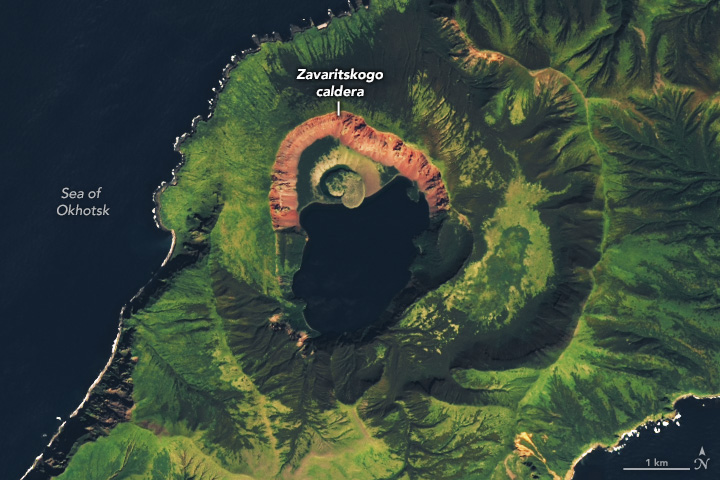Published on 5 February 2025
In the remote northwest corner of the Pacific Ocean, a dotted line of islands stretches between northern Japan and Russia’s Kamchatka Peninsula. The Kuril Archipelago is sparsely populated by humans but riddled with volcanoes.

Tucked away on a remote island in the Pacific, the volcano has recently been pinpointed as the likely source of a sunlight-dimming eruption.
The Zavaritskogo volcano (also called Zavaritskii) is a striking feature on Simushir Island, in the middle of the archipelago. It is made up of nested, steep-walled calderas surrounding a central lake. The OLI (Operational Land Imager) on Landsat 8 captured these images of Zavaritskogo and its complex edifice on September 12, 2024.
The youngest caldera, centered in the detailed image below, is partially outlined by reddish, unvegetated slopes. Since its formation, small eruptions starting around the year 1910 produced cinder cones and lava domes within its bounds. The last documented volcanic activity, in 1957, spewed material that filled in the northwest part of the lake, including a dome 350 meters (1,150 feet) wide and 40 meters (130 feet) high.

September 12, 2024
Past eruptions, however, were much more powerful. New research suggests that Zavaritskogo’s inner caldera may have formed in one of the planet’s largest volcanic eruptions of the 19th century.
Previous analyses of polar ice cores indicated that a major eruption in 1831 had injected several metric tons of sulfur into the stratosphere, reflecting solar radiation back to space and causing the Northern Hemisphere to cool by up to 1 degree Celsius (2 degrees Fahrenheit). And historical accounts from that summer note the Sun appeared green, purple, and blue, which can occur when volcanic particles in the atmosphere scatter sunlight. The probable volcanic source of these phenomena, however, had long remained elusive.
Scientists have now matched the chemical composition of volcanic material preserved in ice cores with that from the most recent major eruption of Zavaritskogo. Radiocarbon dating and estimates for the volume of material ejected from the volcano further implicated Zavaritskogo as the source of the major 1831 eruption.
More volcanic mysteries from that era are left to be solved, the study’s authors noted. The sources of two other eruptions in the early 19th century, signified by sulfur spikes in ice core data, have yet to be identified.
Source:
NASA. (2025, February 5). Nested Calderas of Zavaritskogo. Earth Observatory.